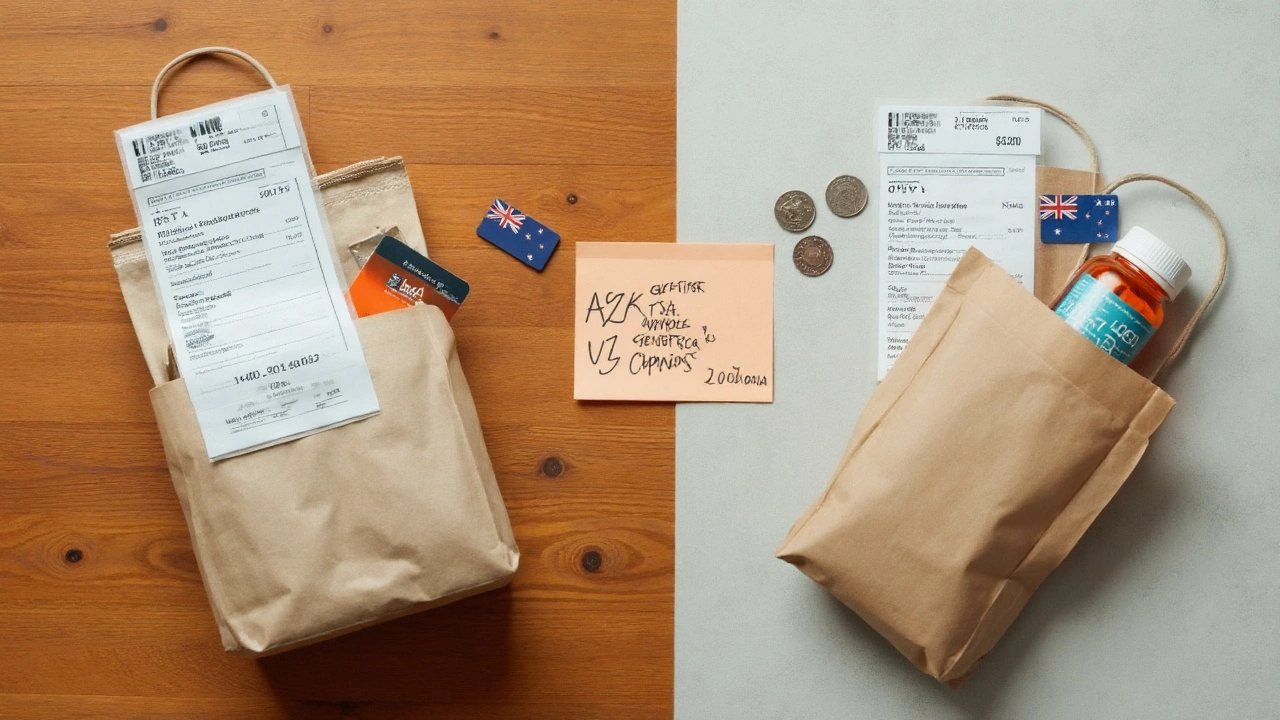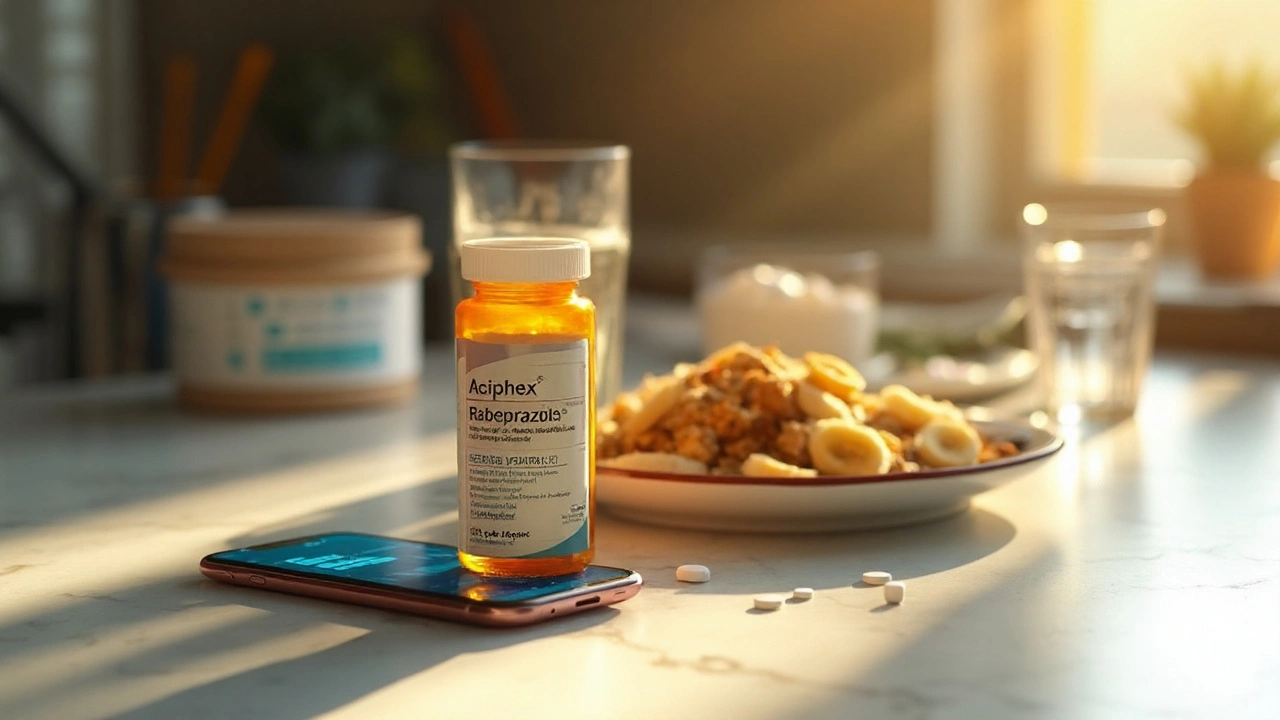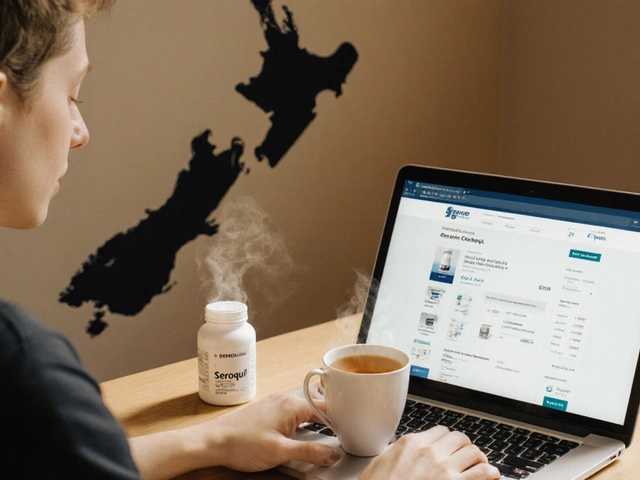If you searched “Aciphex,” you likely want quick, reliable info: what it treats, how to take it right, what to watch for, and whether there’s a better or cheaper option. That’s what you’ll get here-straight talk based on current prescribing info and GI guidelines, plus practical tips from real life. GERD is messy (ask my cat, Kestrel, who thinks 2 a.m. heartburn is treat time), but the plan to manage it doesn’t have to be.
- TL;DR
- Aciphex (rabeprazole) is a prescription proton pump inhibitor (PPI) for GERD, erosive esophagitis, ulcers, H. pylori regimens, and Zollinger-Ellison.
- Typical adult dose: 20 mg once daily for 4-8 weeks; some need long-term maintenance at the lowest effective dose.
- Take it consistently (ideally 30 minutes before breakfast), and don’t crush the delayed‑release tablet. “Sprinkle” capsules exist for kids.
- Common side effects: headache, stomach upset, diarrhea/constipation. Long‑term PPI use has potential risks-use the lowest effective dose and review regularly.
- Alternatives include other PPIs (omeprazole, esomeprazole, pantoprazole) and H2 blockers (famotidine). In NZ, rabeprazole is often subsidised; in the US, generics are far cheaper than brand.
What Aciphex is, what it treats, and how it stacks up
Aciphex is the brand name for rabeprazole, a proton pump inhibitor (PPI). PPIs shut down the acid pumps in your stomach lining. Less acid means less burn, which helps symptoms and gives inflamed tissue time to heal.
Conditions it’s prescribed for (adult indications per the product label and GI guidelines):
- GERD (gastroesophageal reflux disease): relief of symptoms and healing of erosive esophagitis
- Maintenance therapy after healing erosive esophagitis
- Duodenal ulcers
- H. pylori eradication regimen (combined with antibiotics)
- Pathologic hypersecretory conditions, including Zollinger-Ellison syndrome
How fast it works: you might feel improvement within a day or two, but full effect builds over 3-4 days. That’s normal with all PPIs.
Who it’s for: adults with frequent reflux/heartburn (two or more days a week), erosive esophagitis on endoscopy, or when simple measures and on‑demand antacids/H2 blockers aren’t cutting it. There are approved pediatric uses too (more on that below).
Prescription vs OTC: in the US and New Zealand, rabeprazole is prescription‑only. If you need something immediately over the counter, omeprazole, esomeprazole, or lansoprazole are the OTC PPIs; famotidine is an OTC H2 blocker that can help at night or as a bridge.
How rabeprazole compares: all PPIs are more alike than different for heartburn relief. A few quick differences:
- Potency: standard doses are roughly comparable. If one PPI doesn’t work, swapping to another sometimes does.
- Interactions: rabeprazole is less dependent on CYP2C19 than omeprazole/esomeprazole, so it has fewer drug-drug frictions than some peers-but it’s still a PPI, so pH‑dependent interactions apply.
- Food timing: label allows “with or without food,” but most people do better taking it 30 minutes before breakfast for GERD.
Evidence snapshot (why clinicians use it):
- American College of Gastroenterology (ACG) GERD guideline (2022) recommends a once‑daily PPI trial for typical GERD symptoms; step up to twice daily if needed.
- For H. pylori, the ACG (2022 update; reaffirmed 2024) prefers 14‑day bismuth quadruple therapy in many regions due to clarithromycin resistance. Rabeprazole triple therapy is still on labels but works best when clarithromycin susceptibility is known.
- Long‑term maintenance: use the lowest effective dose; consider deprescribing if symptoms are controlled and there’s no ongoing high‑risk condition.
| Use case | Typical adult dose | Usual duration | Notes |
|---|---|---|---|
| Symptomatic GERD | 20 mg once daily | 4-8 weeks | Take consistently; reassess at 4-8 weeks |
| Erosive esophagitis (healing) | 20 mg once daily | 4-8 weeks | Endoscopy follow‑up if severe or alarm features |
| Maintenance of healed esophagitis | Lowest effective dose (often 20 mg daily) | Long‑term | Regular review; try step‑down when stable |
| Duodenal ulcer | 20 mg once daily | Up to 4 weeks | Test and treat H. pylori when relevant |
| H. pylori eradication | 20 mg twice daily + amoxicillin + clarithromycin | 7-14 days | Local resistance matters; bismuth quadruple often preferred |
| Zollinger-Ellison | Start 60 mg daily (titrate) | Individualized | Specialist management; high doses common |
Common reasons people pick rabeprazole over another PPI: fewer interactions than omeprazole/esomeprazole, simply what their clinic uses, or it’s what’s subsidised/formulary‑friendly. In New Zealand, rabeprazole generics (often under “Pariet/rabeprazole” in pharmacies) are usually subsidised; check your local pharmacy for your exact out‑of‑pocket. In the US, generic rabeprazole 20 mg is typically inexpensive with discount programs, while brand Aciphex is costly.

How to take Aciphex safely: dosing, timing, interactions, side effects
Getting the best result from a PPI is about timing, consistency, and fitting the dose to your situation. Here’s a clear, practical plan.
Step‑by‑step for a first PPI trial (adult GERD):
- Pick a time: set a daily reminder 30 minutes before breakfast.
- Take 20 mg once daily for 4 weeks. Don’t crush/chew the delayed‑release tablet.
- Use “rescue” support: antacid or alginate (e.g., Gaviscon) for breakthrough symptoms.
- Reassess at 4 weeks: if better but not quite there, continue to 8 weeks. If still symptomatic, your clinician may increase to twice daily or switch PPIs.
- Once controlled, try step‑down: go to the lowest dose that keeps symptoms at bay, or switch to on‑demand.
Kid‑friendly option: Aciphex Sprinkle (US) is a delayed‑release capsule designed for children who can’t swallow tablets. The capsule can be opened and sprinkled on soft food or in liquid; don’t chew the granules. Typical pediatric dosing (from the US label): ages 1-11 years-5 mg (<15 kg) or 10 mg (≥15 kg) once daily up to 12 weeks; ages 12-16 years-20 mg once daily up to 8 weeks for symptomatic GERD. Pediatric dosing should be clinician‑guided.
Food and timing rules of thumb:
- Label says “with or without food,” but many get better control taking it 30 minutes before breakfast.
- Night reflux? Ask about split dosing (twice daily) or pairing with an evening H2 blocker (famotidine) as a short‑term bridge.
What to avoid with the tablet:
- Don’t split, crush, or chew. It’s enteric‑coated so the drug survives stomach acid and releases in the intestine.
- Don’t take inconsistently. PPIs work by turning off pumps that activate with meals; random timing blunts the benefit.
Drug interactions that matter:
- pH‑dependent absorption: PPIs reduce absorption of drugs needing acid, like ketoconazole, itraconazole, erlotinib, and (importantly) rilpivirine-PPIs are contraindicated with rilpivirine.
- HIV protease inhibitors: atazanavir and nelfinavir levels drop with PPIs-avoid together.
- High‑dose methotrexate: PPIs may increase exposure-oncology teams often pause PPIs around high‑dose cycles.
- Clopidogrel: rabeprazole has less CYP2C19 inhibition than omeprazole/esomeprazole, but there’s still debate. If you must combine clopidogrel with a PPI, cardiology often prefers pantoprazole or rabeprazole, case by case.
- Mycophenolate mofetil: absorption can be reduced-transplant teams usually advise.
Side effects (what’s common vs rare):
- Common: headache, abdominal pain, nausea, diarrhea or constipation, gas. Usually mild and transient.
- Less common but important with long‑term use: low magnesium (can cause cramps, palpitations-often after 3+ months), low vitamin B12 or iron (after years), fundic gland polyps (benign), Clostridioides difficile infection (especially with antibiotics), and small increases seen in observational studies for fractures and certain infections.
- Kidneys and autoimmune concerns: rare cases of acute interstitial nephritis and drug‑induced lupus have been reported with the PPI class. Symptoms like new rash, joint pain, or sudden changes in urine should prompt urgent review.
Red flags: stop and seek urgent care if you have chest pain with sweating/shortness of breath, trouble swallowing, black stools, vomiting blood, unintentional weight loss, persistent vomiting, or new severe abdominal pain. These aren’t “watch and wait” symptoms.
Pregnancy and breastfeeding: modern data suggest PPIs as a class are not linked with major birth defects; omeprazole has the most data and is often first choice. Rabeprazole appears low risk but is less studied; discuss with your obstetric provider. For breastfeeding, PPIs have minimal transfer into milk; many guidelines consider them compatible, with omeprazole/esomeprazole preferred for the depth of evidence.
Liver and kidney health: no dose change is needed for kidney impairment. In moderate to severe liver impairment, rabeprazole exposure is higher-use carefully and monitor. Always tell your prescriber about liver disease.
How to step down or stop without a rebound flare:
- Stabilise first: keep symptoms calm for at least 2-4 weeks.
- Cut to the lowest daily dose, then go to every other day for 1-2 weeks.
- Bridge if needed: add a bedtime H2 blocker (famotidine) or an alginate for 2-3 weeks.
- Stop and reassess. If symptoms recur often, you may be a maintenance‑dose person-no shame in that.
Everyday tweaks that compound the benefit:
- Aim for a light evening meal and avoid lying down for 3 hours after dinner.
- Go easy on trigger foods/drinks: alcohol, peppermint, chocolate, fatty or spicy meals, and large late meals are usual culprits.
- Elevate the head of the bed 10-15 cm for night reflux (blocks under the bed legs beat extra pillows).
- Work on steady weight loss if you carry central weight-it matters more than any “magic” food.

Costs, alternatives, quick answers, and next steps
Costs and access (2025 snapshot):
- United States: generic rabeprazole 20 mg is typically inexpensive with discount cards; brand Aciphex can be several hundred dollars monthly. Ask your pharmacist to price generic first.
- New Zealand (Wellington is home for me): rabeprazole generics are commonly subsidised. Many people pay little or nothing at the pharmacy, depending on current policy and your situation. Check with your local chemist-they’ll know the exact details today.
Alternatives if rabeprazole isn’t right for you:
- Other PPIs: omeprazole, esomeprazole, lansoprazole, pantoprazole, dexlansoprazole. If one PPI doesn’t help, switching sometimes does.
- H2 blockers: famotidine for milder or night symptoms, or as an add‑on while you taper a PPI.
- Alginates/antacids: on‑demand symptom relief, especially after trigger meals.
- Non‑drug approaches: weight loss, bed head elevation, meal timing changes, and avoiding late heavy meals.
- Procedures: for select patients with proven reflux and poor medication response-surgical fundoplication or endoscopic options. Needs specialist assessment.
Is there a “best” PPI? Not universally. If you’re on drug A and still miserable, your next best move is often either a dose‑timing fix, a dose increase/split, or a switch to another PPI-rather than adding a long list of extras. Your clinician will factor in interactions, insurance/formulary, and your symptom pattern.
Quick decision rules you can use now:
- Heartburn ≥2 days/week? A proper 4-8 week PPI trial makes sense.
- Heartburn mainly at night? Ensure early dinner, bed head elevation, consider split PPI dosing or add short‑term bedtime famotidine.
- No relief after 8 weeks on correct PPI use? Time to reassess: adherence, timing, dose, switch PPI, test for H. pylori, or check for non‑acid causes. Consider endoscopy if alarm features or age/risk factors.
- Fine on daily PPIs but want “less medicine”? Try alternate‑day dosing plus alginate rescue. If symptoms recur often, maintenance may be safer than frequent flares.
Mini‑FAQ
- How long until I feel better? Many feel some relief in 24-48 hours; full effect takes 3-4 days.
- Can I take it at night? Morning before breakfast gives best daytime control. For night reflux, some split to twice daily under clinician advice.
- Can I drink coffee? Probably, but coffee is a trigger for some. Try half‑caf, smaller cups, and don’t pair with rich, fatty foods.
- Do PPIs cause dementia or fractures? Data are mixed and mostly observational. If there’s a risk, it’s small. Use the lowest effective dose, keep vitamin D and calcium adequate, and re‑evaluate yearly.
- Will I become “dependent”? Not in the addictive sense. But stopping suddenly can cause rebound acid for 1-2 weeks. Tapering helps.
- Is rabeprazole safe with pregnancy? Likely low risk, but omeprazole has the most data and is often preferred. Decide with your obstetric provider.
- What about H. pylori? Don’t DIY. The right antibiotics depend on local resistance. Confirm eradication 4+ weeks after therapy (off PPIs for 2 weeks before testing if possible).
Risks and how to reduce them:
- Low magnesium: ask for magnesium levels if you get cramps, palpitations, or fatigue on long‑term PPIs.
- Infections: use antibiotics only when needed; wash hands well; consider probiotics if you’re on antibiotics (talk to your clinician).
- B12/iron: long‑term users with anemia or neurologic symptoms should be checked.
- Kidney: new swelling, rash, or a sudden rise in blood pressure should be reviewed promptly.
Pro tips I give readers who message me from around Wellington:
- Set a phone alarm 30 minutes before breakfast. Consistency trumps everything.
- If late‑night heartburn is your nemesis, move dinner earlier by 60-90 minutes and elevate the bed head. It’s unsexy, but it works.
- Keep an “SOS kit”: alginate after risky meals; famotidine for short‑term night support; peppermint tea is not your friend if reflux rules your life.
- Don’t stack PPIs. If one isn’t working, talk to your clinician to switch rather than doubling yourself.
Next steps (choose your path):
- If you’re new to PPIs: start 20 mg once daily 30 minutes before breakfast for 4 weeks, plus lifestyle tweaks. Reassess at 4 weeks.
- If you’re partly better: continue to 8 weeks; consider split dosing or a different PPI if you’ve nailed timing/adherence.
- If you’re controlled and want less: step down gradually; use alginate or an H2 blocker as a bridge.
- If you’re not improving: verify you’re taking it right, then ask about switching PPIs, adding testing (H. pylori, pH, endoscopy), or evaluating non‑acid causes.
- If you have alarm features (trouble swallowing, bleeding, weight loss, persistent vomiting): seek urgent evaluation.
Where this information comes from: FDA Prescribing Information for rabeprazole (Aciphex), latest label updates; Medsafe NZ rabeprazole datasheet; American College of Gastroenterology GERD guideline (2022) and H. pylori guidance (2022, reaffirmed 2024); NICE dyspepsia/GERD recommendations; and typical pharmacology text references for class effects and interactions. This is general information, not personal medical advice-your own clinician’s guidance wins, every time.






Written by Martha Elena
I'm a pharmaceutical research writer focused on drug safety and pharmacology. I support formulary and pharmacovigilance teams with literature reviews and real‑world evidence analyses. In my off-hours, I write evidence-based articles on medication use, disease management, and dietary supplements. My goal is to turn complex research into clear, practical insights for everyday readers.
All posts: Martha Elena